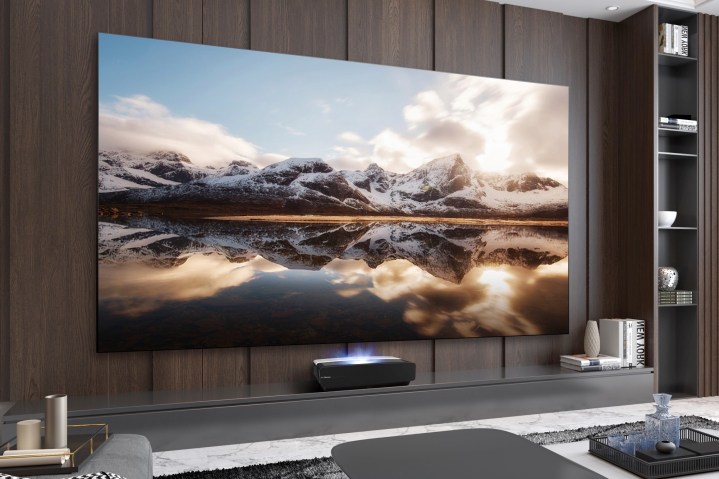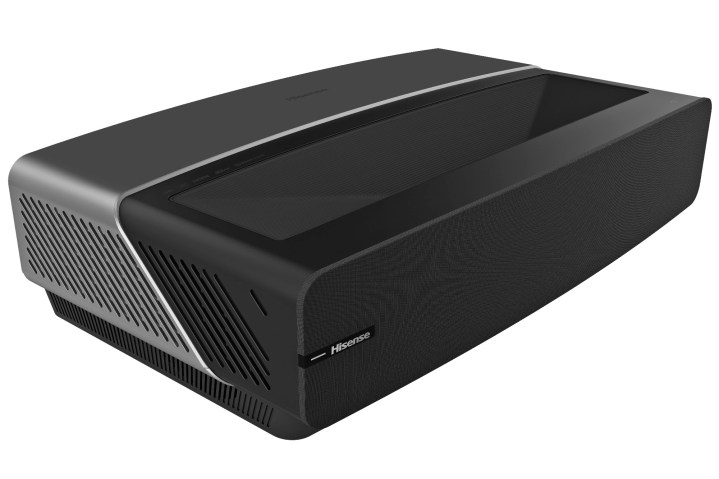
Projectors are still king when it comes to getting the biggest image for the lowest possible price. And if you want all the benefits of a projected image, without the many inconveniences that using a projector normally entails, Hisense’s 12o-inch L5F Laser Cinema might be the way to go. It’s available now for $5,000.
Unlike conventional projectors that must be placed several feet away from the screen, the L5F is a laser TV, which means that it can sit just 13 inches away, thanks to its ultra-short-throw (UST) design. Laser TVs also remove the need to replace expensive bulbs, and they typically come with TV tuners, built-in speakers, and full smart TV operating systems and features.
This is true of the L5F, but Hisense takes this all-in-one concept even further by packaging the L5F with its own dedicated 120-inch, ambient light-rejecting screen. Most projectors and laser TVs require that you buy your own screen, which can add hundreds of dollars or more to the price of a setup.
The L5F uses a single blue laser as its light source, which is then converted to all of the colors of the spectrum using color filters. While not as accurate as triple-laser systems, Hisense’s blue laser can still pump out a very respectable maximum brightness of almost 2,700 lumens, and it costs considerably less than triple- or dual-laser models. That brightness lets the L5F support HDR10 and HLG high dynamic range (HDR) formats. Hisense claims the L5F can exceed the Rec. 709 standard UHD color range and can reach 83% of DCI-P3, which is the standard used by most filmmakers when preparing movies for commercial theatrical release.

With Android TV as the operating system, you get access to thousands of apps and streaming services, plus the ability to use Chromecast and Google Assistant. Normally, we wouldn’t pay much attention to a laser TV’s audio system, but with a dual-30 watt set of stereo speakers with dbx-tv processing, the L5F might actually sound pretty good without any help from additional speakers or soundbars.
The L5F’s included 120-inch screen should ensure that you get the best possible picture quality thanks to its ambient light-rejecting coating, but it could prove challenging for some folks to set up on their own.
We’ve never assembled one of these screens, but a quick look at the reviews on Amazon for Hisense’s smaller, 100-inch version reveals that it can take several hours to get things set up correctly. If that doesn’t sound like something you want to attempt, Hisense can arrange for a professional installation. Hisense charges $225 for the first hour and then $75 per hour after that because it takes two techs to mount the screen — which would indicate that the Amazon reviews are not just from folks who neglected to read the instructions.
Another caveat to be aware of: Many laser TVs from other manufacturers offer a range of supported image sizes that can be altered by moving the laser TV closer or farther away from their screens. The L5F, on the other hand, has a fixed projection size. If you want the smaller, 100-inch image size, you have to buy that model.
Editors' Recommendations
- TCL prices its insanely bright, 115-inch QM89 4K TV at $27,000
- Hisense teases 110-inch, 10,000-nit TV ahead of CES 2024
- Leica launches the Hisense-powered $8,300 Cine 1, its first 4K Laser TV, at CES 2023
- Sling TV raises its prices by $5 per month for new subscribers
- Hisense’s 2020 TV lineup features hands-free voice and a $6,000 laser TV



